Sauce chasseur, sometimes called "hunter's sauce", is a simple or compound brown sauce used in French cuisine. It is typically made using demi-glace or espagnole sauce (among the five mother sauces) as a base, and often includes mushrooms and shallots. It may also include tomatoes and a finishing of fines herbes . [1]
The name is derived from the French word for "hunter", alluding to the traditional pairings with venison, rabbit, wild fowl, and other game meats. Traditionally, while returning from the hunt, the hunters would pick the mushrooms that they would subsequently use for their preparation.[ citation needed ]
Chasseur is thought to have been invented by Philippe de Mornay, who is also credited with inventing Mornay sauce, Béchamel, sauce Lyonnaise, and sauce Porto. [2]

French cuisine is the cooking traditions and practices from France. In the 14th century, Guillaume Tirel, a court chef known as "Taillevent", wrote Le Viandier, one of the earliest recipe collections of medieval France. In the 17th century, chefs François Pierre La Varenne and Marie-Antoine Carême spearheaded movements that shifted French cooking away from its foreign influences and developed France's own indigenous style.
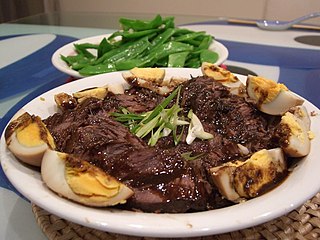
Braising is a combination-cooking method that uses both wet and dry heats: typically, the food is first browned at a high temperature, then simmered in a covered pot in cooking liquid. It is similar to stewing, but braising is done with less liquid and usually used for larger cuts of meat. Braising of meat is often referred to as pot roasting, though some authors make a distinction between the two methods, based on whether additional liquid is added. Osso buco and coq au vin are well known braised meat dishes, and the technique can also be used to prepare fish, tempeh, tofu or fruits and vegetables.

In cooking, a sauce is a liquid, cream, or semi-solid food, served on or used in preparing other foods. Most sauces are not normally consumed by themselves; they add flavor, moisture, and visual appeal to a dish. Sauce is a French word taken from the Latin salsa, meaning salted. Possibly the oldest recorded European sauce is garum, the fish sauce used by the Ancient Romans, while doubanjiang, the Chinese soy bean paste is mentioned in Rites of Zhou in the 3rd century BC.

A mirepoix is a mixture of diced vegetables cooked with fat for a long time on low heat without coloring or browning. The ingredients are not sautéed or otherwise hard-cooked, because the intention is to sweeten rather than caramelize them. Mirepoix is a long-standing part of French cuisine and is the flavor base for a wide variety of dishes, including stocks, soups, stews, and sauces.

A Mornay sauce is a béchamel sauce with shredded or grated cheese added. Some variations use different combinations of Gruyère, Emmental cheese, white cheddar or even Parmesan cheese. A Mornay sauce made with cheddar is commonly used to make macaroni and cheese.

Chateaubriand is a dish that traditionally consists of a large front cut fillet of tenderloin grilled between two lesser pieces of meat that are discarded after cooking. While the term originally referred to the preparation of the dish, Auguste Escoffier named the specific front cut of the tenderloin the Chateaubriand.
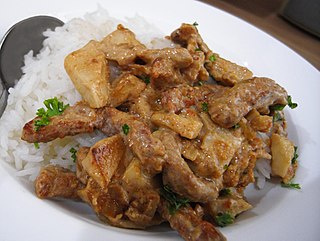
Beef stroganoff or beef stroganov is a Russian dish of sautéed pieces of beef in a sauce of mustard and smetana. From its origins in mid-19th-century Russia, it has become popular around the world, with considerable variation from the original recipe. Mushrooms are common in many variants.

A schnitzel is a thin slice of meat. The meat is usually thinned by pounding with a meat tenderizer. Most commonly, the meat is breaded before frying. Breaded schnitzel is popular in many countries and is made using veal, pork, chicken, mutton, beef, or turkey. Schnitzel is very similar to the dish escalope in France and Spain, panado in Portugal, tonkatsu in Japan, cotoletta in Italy, kotlet schabowy in Poland, milanesa in Latin America, chuleta valluna in Colombia, chicken chop in Malaysia, and chicken-fried steak and pork tenderloin of the United States.
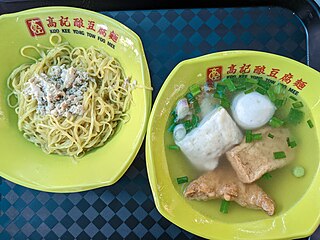
Yong tau foo is a Hakka Chinese dish consisting primarily of tofu filled with ground meat mixture or fish paste. Variation of this food include vegetables and mushrooms stuffed with ground meat or surimi. Yong tau foo is eaten in numerous ways, either dry with a sauce or served as a soup dish.
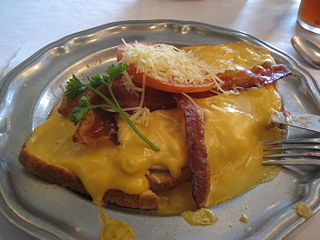
A Hot Brown sandwich is an American hot sandwich originally created at the Brown Hotel in Louisville, Kentucky, by Fred K. Schmidt in 1926. It is a variation of traditional Welsh rarebit and was one of two signature sandwiches created by chefs at the Brown Hotel shortly after its founding in 1923. It was created to serve as an alternative to ham and egg late-night dinners.

Beef bourguignon or bœuf bourguignon, also called beef Burgundy, and bœuf à la Bourguignonne, is a French beef stew braised in red wine, often red Burgundy, and beef stock, typically flavored with carrots, onions, garlic, and a bouquet garni, and garnished with pearl onions, mushrooms, and bacon. A similar dish using a piece of braised beef with the same garnish is pièce de bœuf à la bourguignonne.

Gratin is a culinary technique in which an ingredient is topped with a browned crust, often using breadcrumbs, grated cheese, egg or butter. The term may be applied to any dish made using this method. Gratin is usually prepared in a shallow dish of some kind. A gratin is baked or cooked under an overhead grill or broiler to form a golden crust on top and is often served in its baking dish.
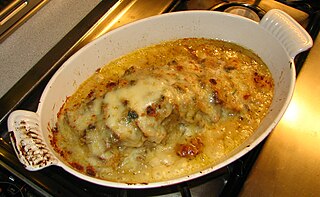
Veal Prince Orloff, veal Prince Orlov, veal Orloff, or veal Orlov is a 19th-century dish of French cuisine, which was created by the French chef Urbain Dubois in the employ of Prince Orloff, former Russian ambassador to France. The dish consists of a braised loin of veal, thinly sliced, filled with a thin layer of finely chopped mushrooms (duxelles) and onions between the slices, then reassembled in the original shape. It is then topped with Mornay sauce and browned in the oven.
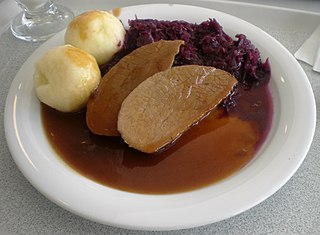
Sauce bourguignonne is a French sauce with a base of red wine with onions or shallots, a bouquet garni (parsley, thyme and bay leaf), reduced, strained, and mixed with some espagnole sauce. Just before serving it is mounted with butter and seasoned lightly with cayenne pepper. Like all red wine sauces, it may have some mushrooms added during cooking to enrich the flavour.

A meatball is ground meat (mince) rolled into a ball, sometimes along with other ingredients, such as bread crumbs, minced onion, eggs, butter, and seasoning. Meatballs are cooked by frying, baking, steaming, or braising in sauce. There are many types of meatballs using different types of meats and spices. The term is sometimes extended to meatless versions based on vegetables or fish; the latter are also commonly known as fish balls.

Oyster sauce describes a number of sauces made by cooking oysters. The most common in modern use is a viscous dark brown condiment made from oyster extracts, sugar, salt and water, thickened with corn starch.

Chicken chasseur is a French dish, known in France as poulet chasseur, poulet à la chasseur or poulet sauté chasseur). It consists of fried chicken served hot, with sauce chasseur, which is based on mushrooms, onions or shallots, tomatoes and wine and may also contain stock and various herbs. The name derives from the French chasseur, meaning "hunter".

Florentine or à la Florentine is a term from classic French cuisine that refers to dishes that typically include a base of cooked spinach, a protein component and Mornay sauce. Chicken Florentine is the most popular version. Because Mornay sauce is a derivation of béchamel sauce which includes roux and requires time and skill to prepare correctly, many contemporary recipes use simpler cream based sauces.